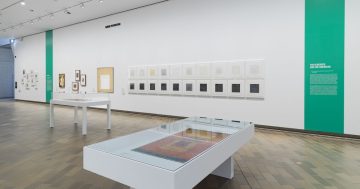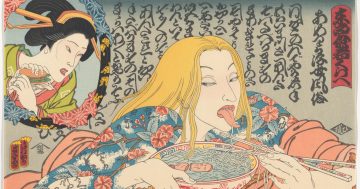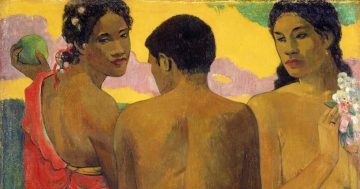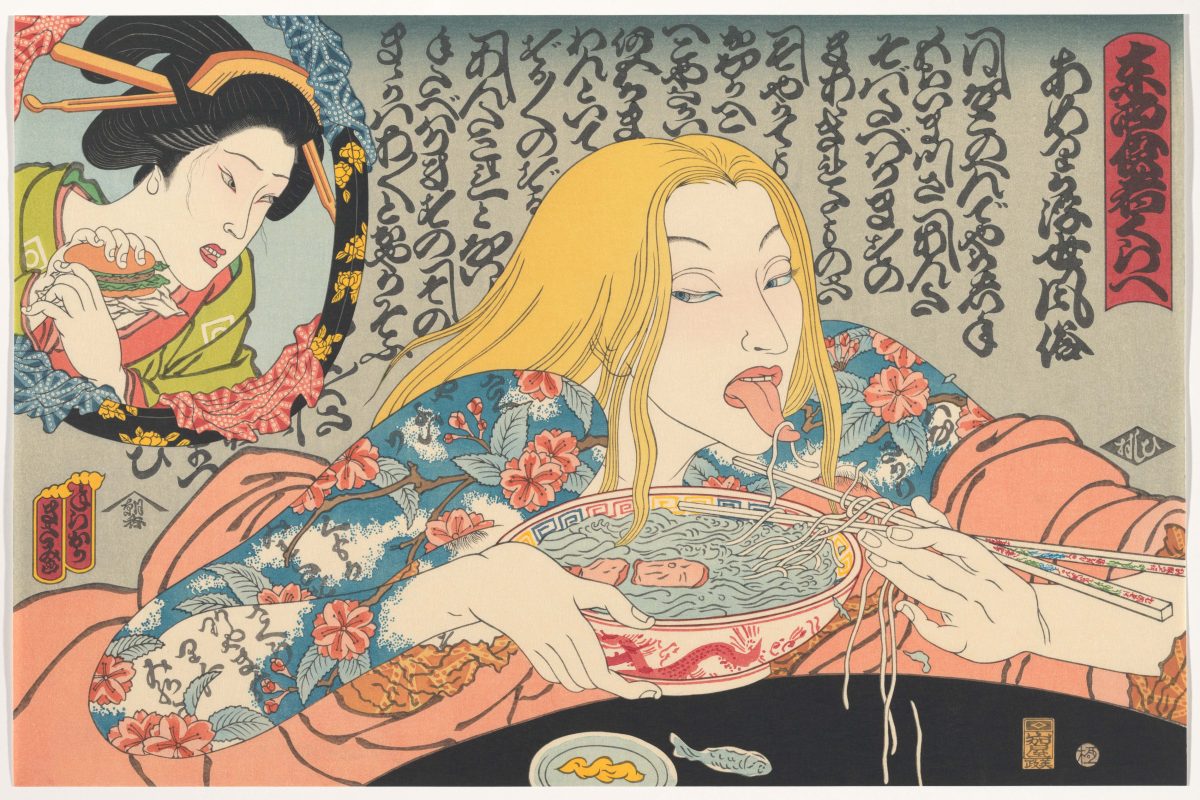
Masami Teraoka, Motoharu Asaka, Satoshi Hishimura, Keizo Sato, Makoto Nakayama, Ichibei Iwano, McDonald’s hamburgers invading Japan/Tattooed woman and geisha III, 2018, National Gallery of Australia, Kamberri/Canberra, purchased 2024 © The artist. Photo: NGA.
Masami Teraoka is an interesting phenomenon in American art. Born in Japan in 1936, he shifted to Los Angeles in 1961 to continue with his art studies and stayed in the United States.
He’s an artist in love with narrative and not afraid of taking a political and ethical stance. He is possibly best known for his hard-hitting paintings denouncing hypocrisy in the Roman Catholic Church over sexual abuse by clergy and is presently embroiled in American politics surrounding the upcoming presidential election.
The gorgeous Masami Teraoka and Japanese Ukiyo-e Prints exhibition, beautifully and tightly curated by Beatrice Thompson and Kira Godoroja-Prieckaerts, focusses on his early prints and their later incarnations.
As the artist observed: “My McDonald’s Hamburgers Invading Japan and 31 Flavours Invading Japan Series in the 1970s and AIDS Series in the 1980s reflect my cultural heritage from Japan. The Ukiyo-e or wood block print tradition represents my cultural identity. Geisha and samurai images I use are a way to depict traditional-thinking Japanese people.”
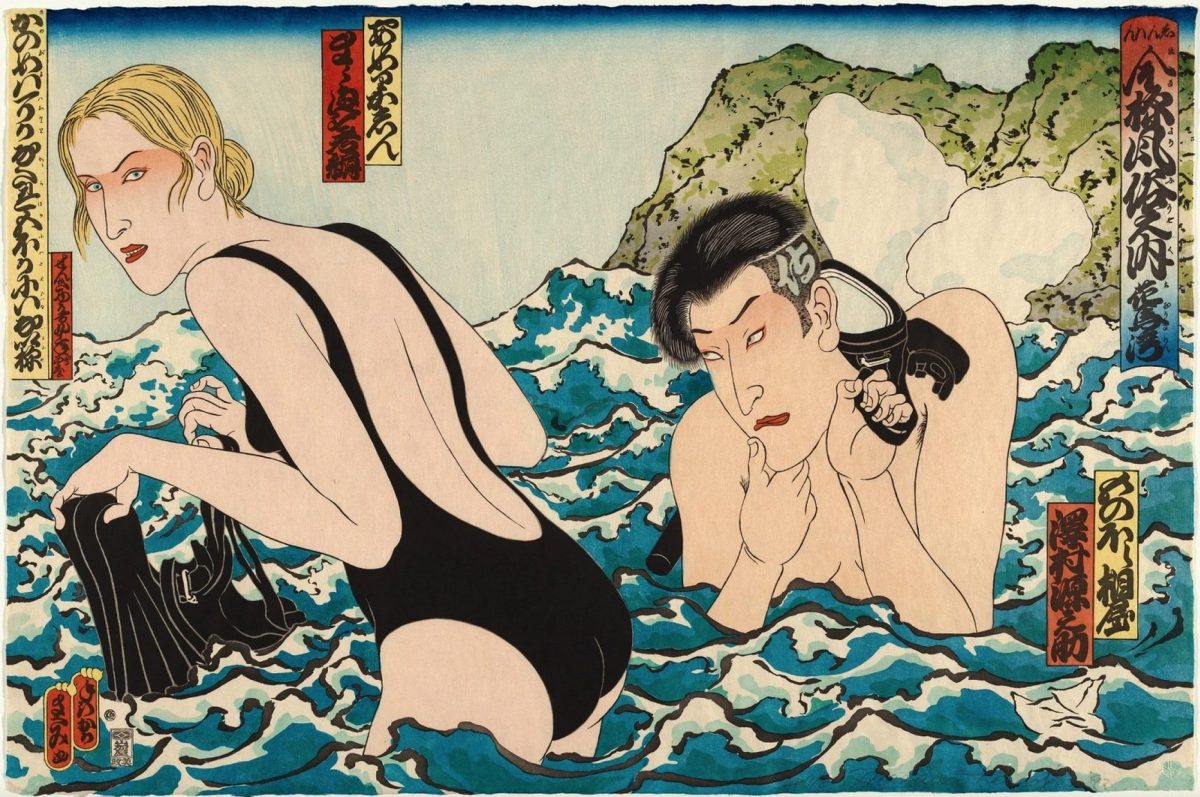
Masami Teraoka, Tyler Graphics Ltd Mount Kisco New York, Longing samurai, 1992, National Gallery of Australia, Kamberri/Canberra, gift of Kenneth Tyler 2002 © The artist and Kenneth E Tyler. Photo: NGA.
Teraoka developed a wonderful hybrid style – like a collision between the Japanese traditional woodblock prints and American pop art, especially the sexualised imagery of Tom Wesselman.
Teraoka drew on the Japanese heritage of kabuki theatre prints with their beautiful women and the shunga erotic prints with their explicit graphic sexuality. He invented his cast of characters who played out the farcical dramas with colourful theatrical flair.
Ken Tyler, the American master printer of genius, helped to realise these prints, frequently in a hybrid technique that drew on traditional Japanese mokuhanga and Western European traditions of etching.
Imagine the horror when McDonald’s “invaded” Japan and opened its first store in 1971. In the print (top), a geisha on the left apprehensively holds a hamburger while a tattooed woman slurps a bowl of Japanese noodles. The background script captures the dialogue interrogating how one should eat a hamburger.
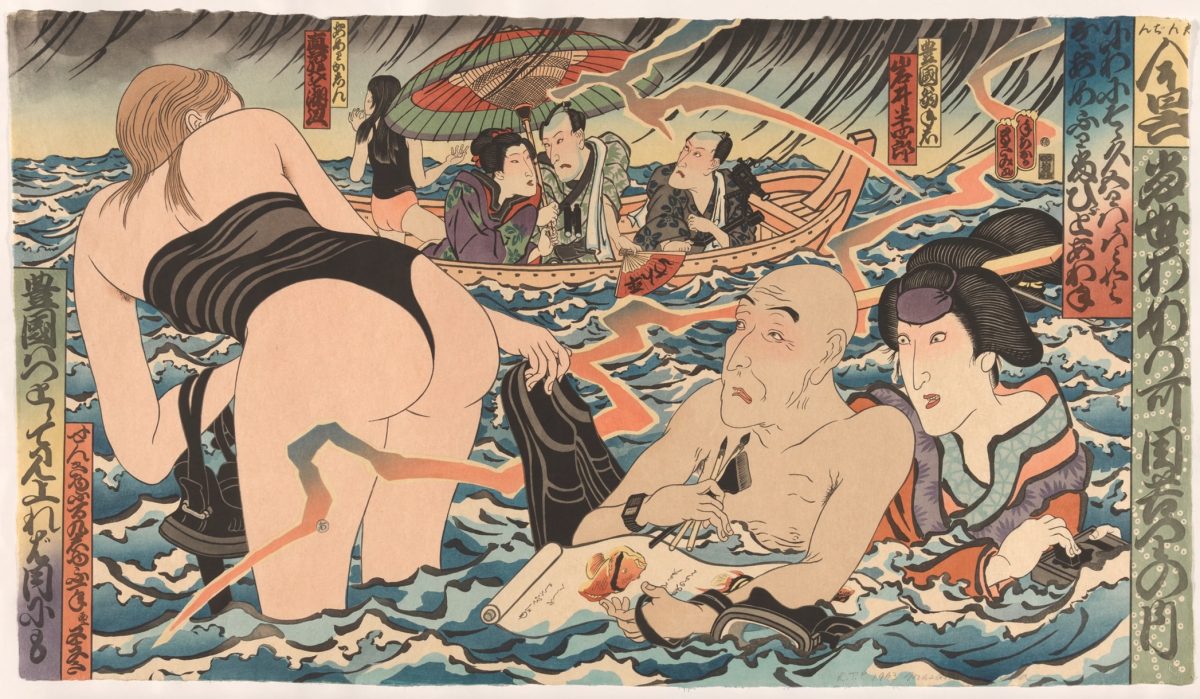
Masami Teraoka, Kunisada eclipsed, 1993, relief, intaglio woodcut, etching, aquatint and hand colouring. National Gallery of Australia, Canberra. Purchased 1993 © The artist and Kenneth E Tyler. Photo: NGA
One of my favourites, Kunisada Eclipsed, 1993, tells the story of how the Japanese woodblock master, Utagawa Kunisada I, visited Hawaii with an assistant to depict its natural beauties and the eclipse. The scholar artist’s concentration is disrupted when an American woman emerges out of the water and strikes him with her sensuous proportions.
This clash of Japanese and American civilisations in Hawaii is like a bolt of lightning, and the lightning is dutifully recorded. As the caption notes in Japanese: “Suddenly the sky darkens, heavy rain starts to fall and the tourist panics.”
There is plenty of tongue-in-cheek humour, verbal and visual puns and references to Japanese and American culture. Sarah and Octopus/Seventh Heaven, 2001, references one of the most famous erotic prints in Japanese art.
This is Katsushika Hokusai’s Dream of the fisherman’s wife, 1814, where the woman is in erotic ecstasy as she is seduced by an octopus. Teraoka’s Sarah meets her octopus in the waves and holds up a female condom as a plea for safe sex practices.
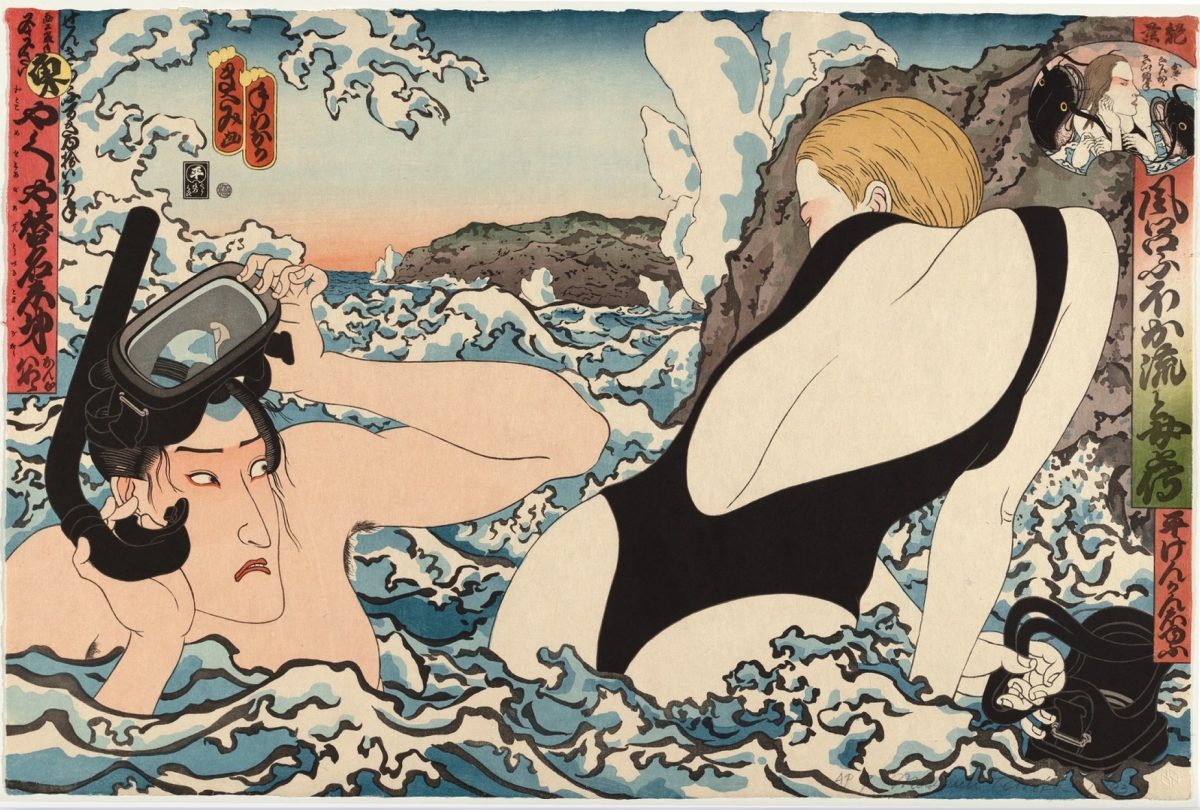
Masami Teraoka, Tyler Graphics Ltd Mount Kisco New York, View from here to eternity, 1993, National Gallery of Australia, Kamberri/Canberra, purchased with the assistance of the Orde Poynton Fund 2002 © The artist and Kenneth E Tyler. Photo: NGA.
The beauty of this exhibition is that it marries up Teraoka’s work with some of its Japanese sources to create this rich fabric of associations.
Teraoka is the supreme puppet master who pulls the strings and controls his performing characters with humour and eroticism. However, one feels he is not here simply to entertain the audience, but also to instruct it and encourage it to question the values being advanced by institutions and sanctified by tradition.
It is a deeply absorbing exhibition, where after a while you come to realise that beyond the surface glamour and raucous humour, the artist challenges us to think and question our values.
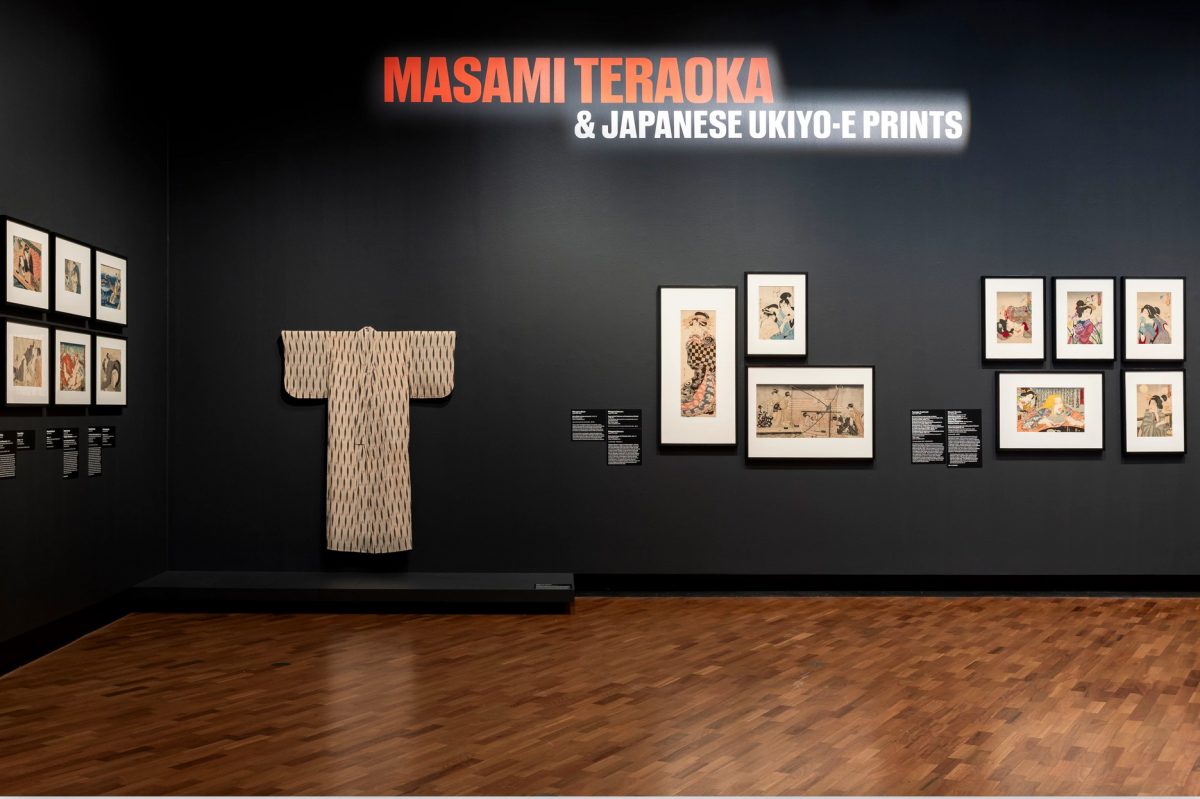
Masami Teraoka and Japanese Ukiyo-e Prints, installation view, National Gallery of Australia, Kamberri/Canberra, 2024. Photo: NGA.
Masami Teraoka and Japanese Ukiyo-e Prints is on exhibition at the National Gallery of Australia, daily from 10 am to 5 pm, until 2 March 2025. Admission is free.












